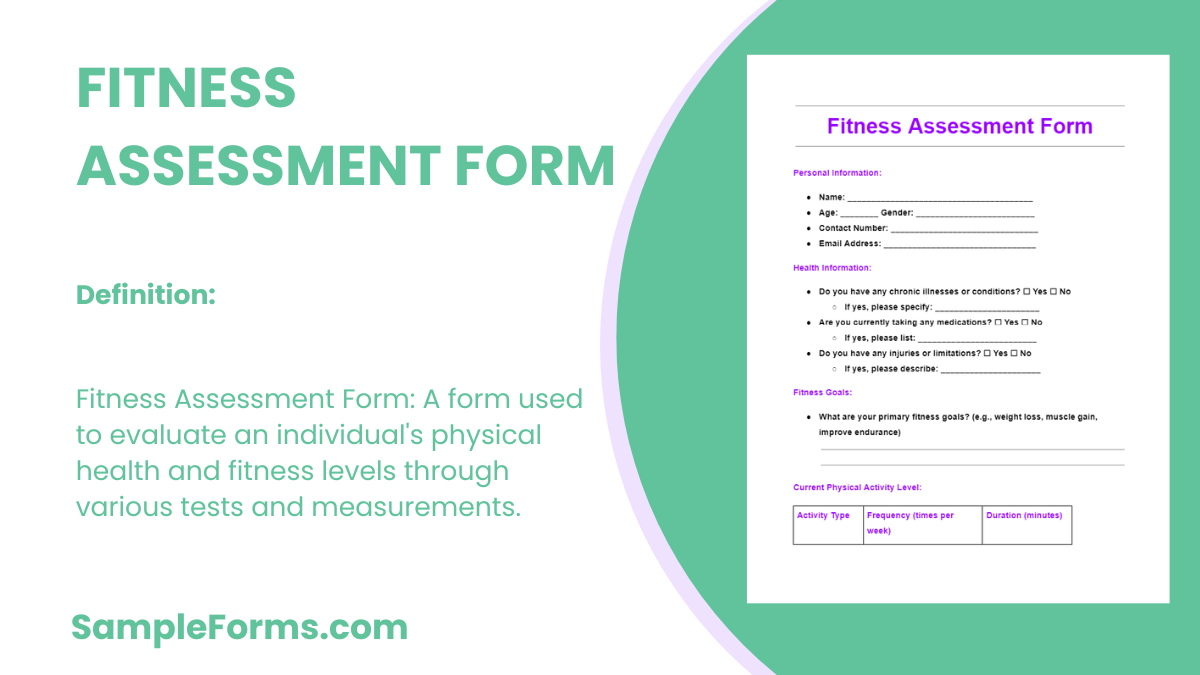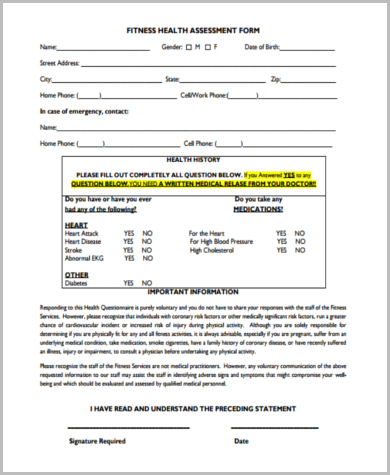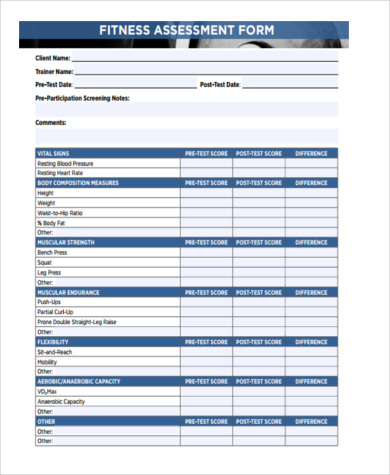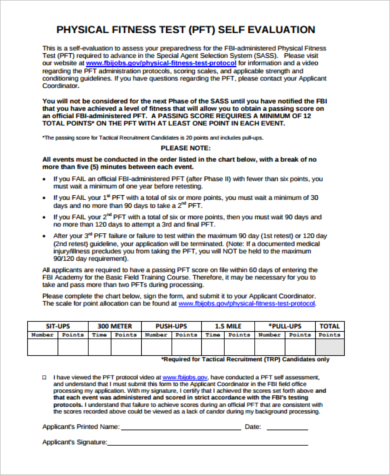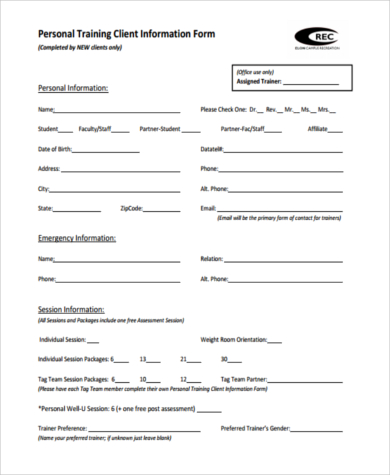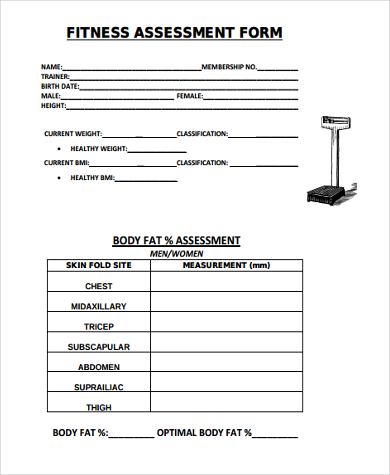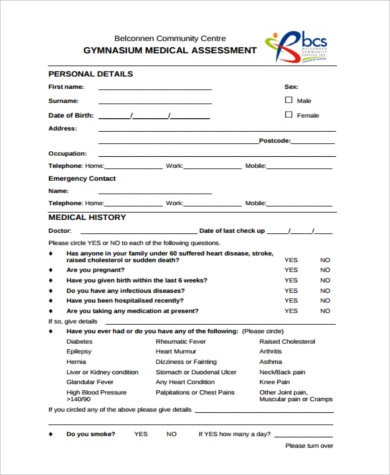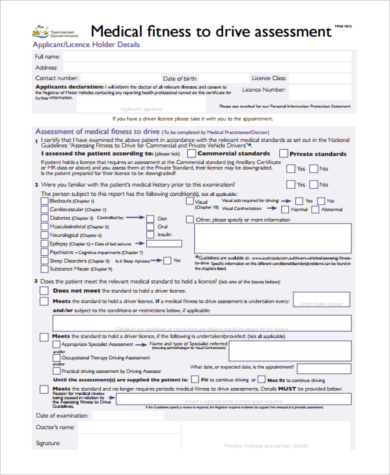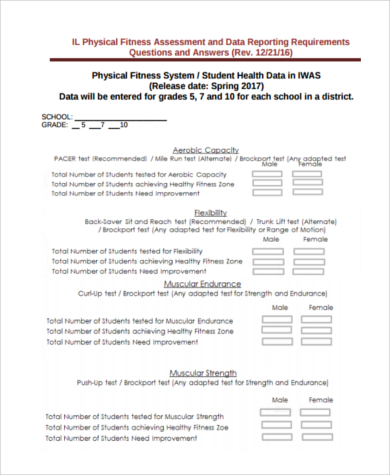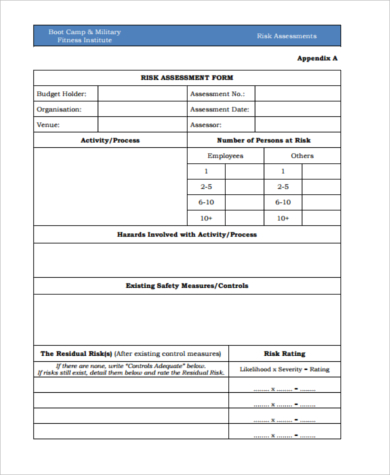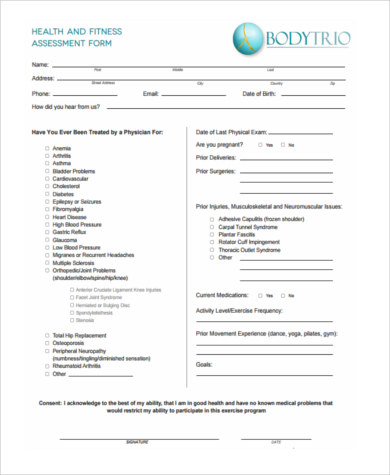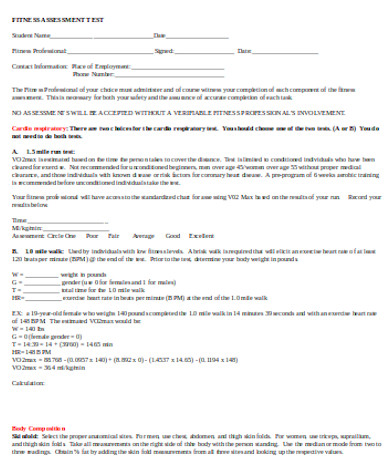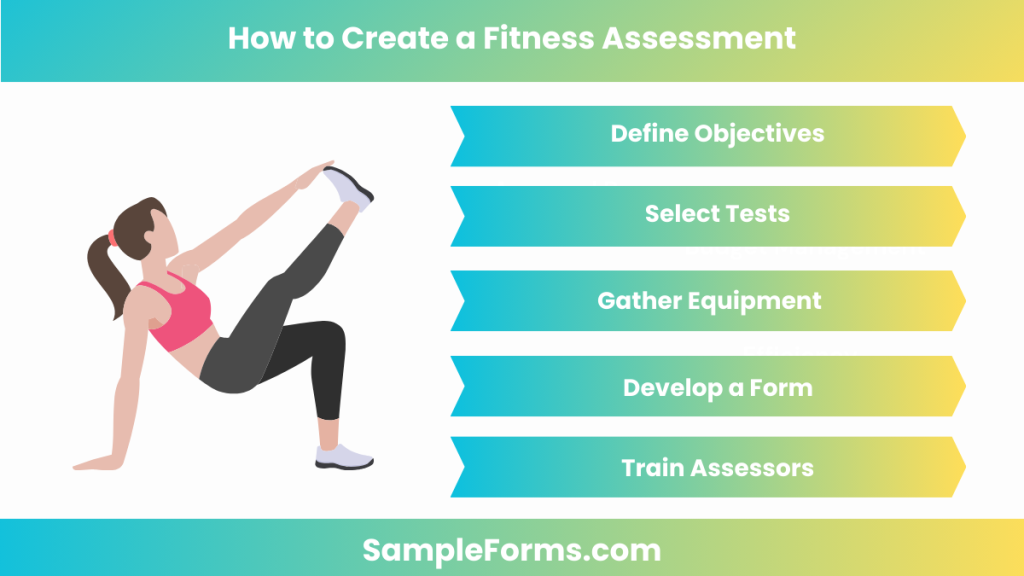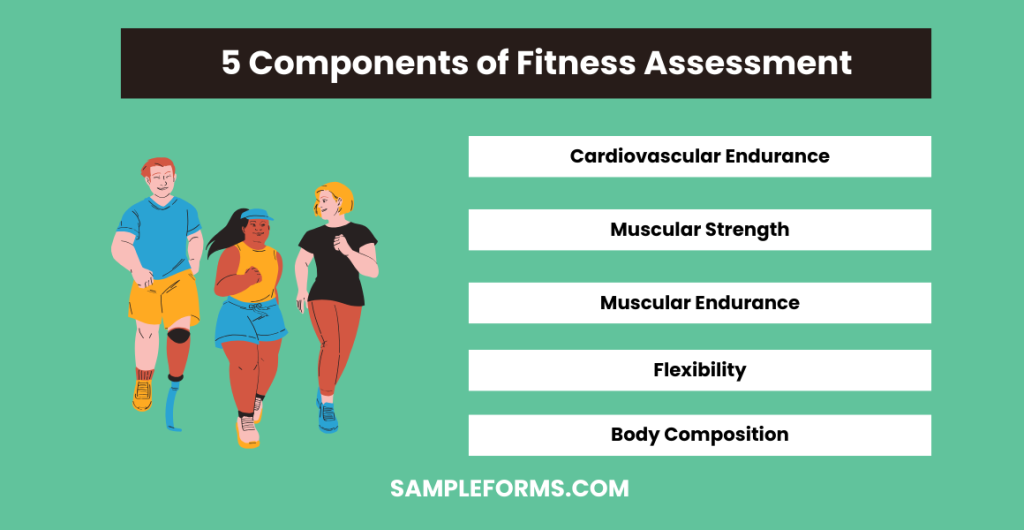A Fitness Assessment Form is essential for evaluating your current fitness level and tracking progress over time. This comprehensive guide covers everything you need to know about creating and using a Fitness Form effectively. From understanding the key components of an Assessment Form to providing detailed examples, our guide offers practical advice to help you assess and improve your fitness. Whether you’re a personal trainer or someone embarking on a fitness journey, this guide will help you gather the necessary data to make informed decisions about your fitness routine and goals.
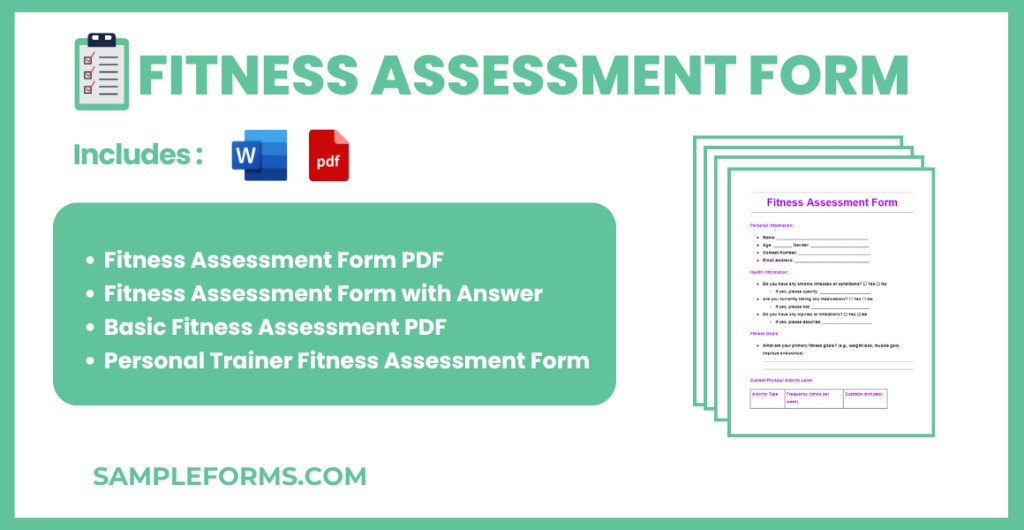
Download Fitness Assessment Form Bundle
What is Fitness Assessment Form?
A Fitness Assessment Form is a document used to evaluate an individual’s current fitness level. This Assessment Form includes various tests and measurements, such as cardiovascular endurance, muscular strength, flexibility, and body composition. It helps trainers and individuals identify strengths and areas for improvement, set realistic goals, and monitor progress. By using a structured form, you can ensure a comprehensive assessment that provides valuable insights into your fitness status and guides your training program effectively.
Fitness Assessment Format
Fitness Assessment Form
1. Client Information
- Client Name:
- Age:
- Gender:
- Contact Information:
2. Health and Fitness Background
- Medical History:
- Current Physical Activity Level:
- Fitness Goals:
3. Assessment Details
- Height:
- Weight:
- Body Mass Index (BMI):
- Body Fat Percentage:
4. Fitness Tests
- Cardiovascular Fitness:
- Strength:
- Flexibility:
- Endurance:
5. Results and Recommendations
- Assessment Results:
- Personalized Fitness Plan:
6. Signature
- Client’s Signature:
- Date:
Fitness Assessment Form PDF
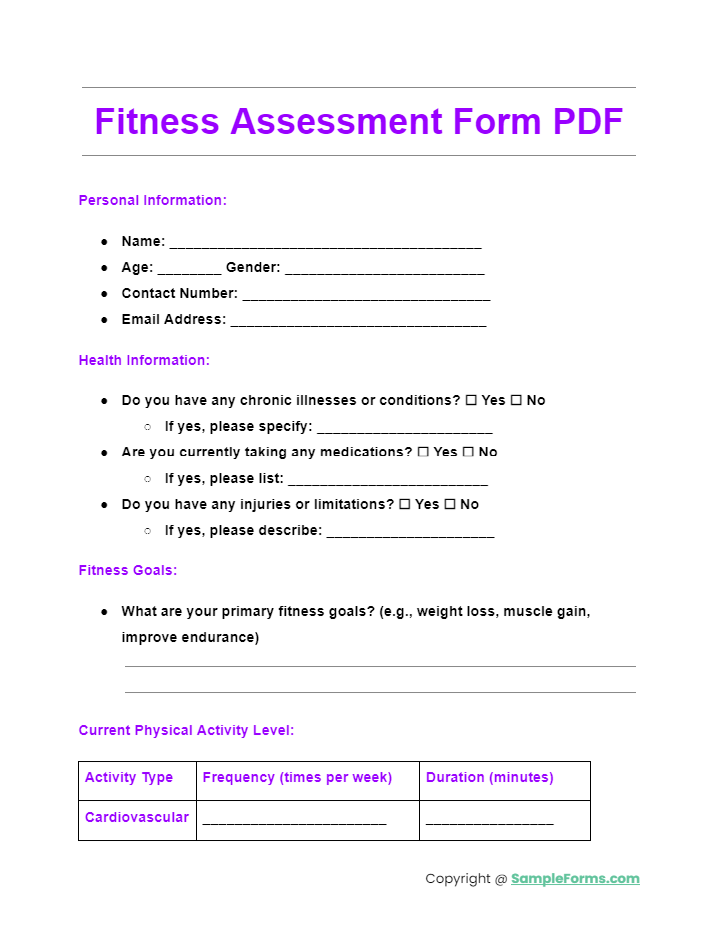
A Fitness Assessment Form PDF offers a convenient, printable format for conducting fitness evaluations. This form ensures consistency and accuracy in recording results, similar to a Risk Assessment Form, making it easy to track progress. In addition, you should review our Assessment Form for Intake
Fitness Assessment Form with Answer
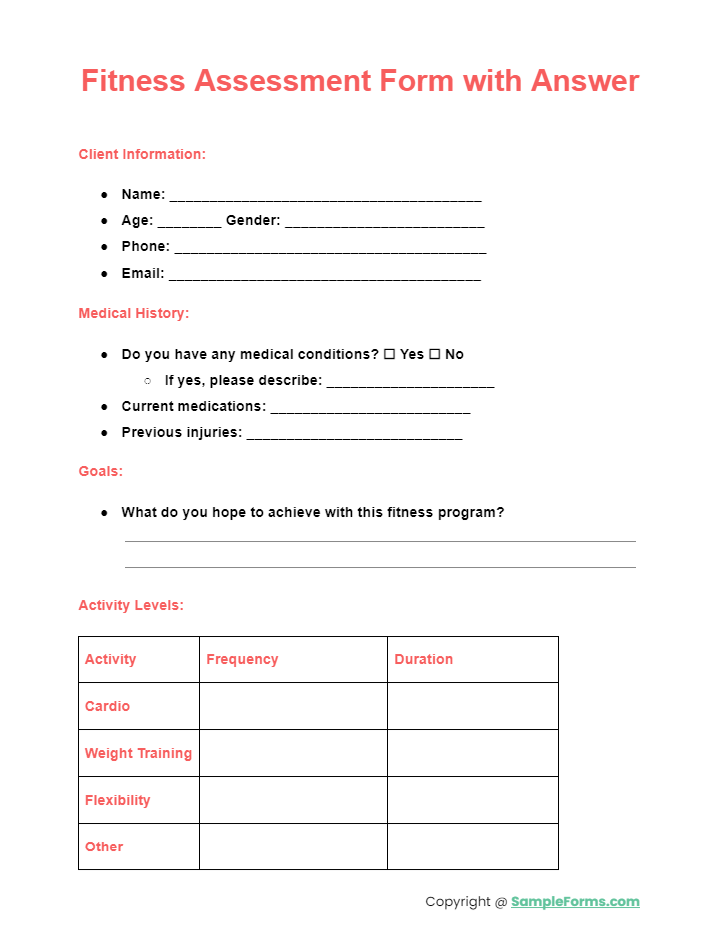
A Fitness Assessment Form with Answer provides a comprehensive guide to understanding and interpreting assessment results. This format aids in accurate analysis, much like an Interview Assessment Form, helping users set informed fitness goals. In addition, you should review our Fitness Feedback Form
Basic Fitness Assessment PDF
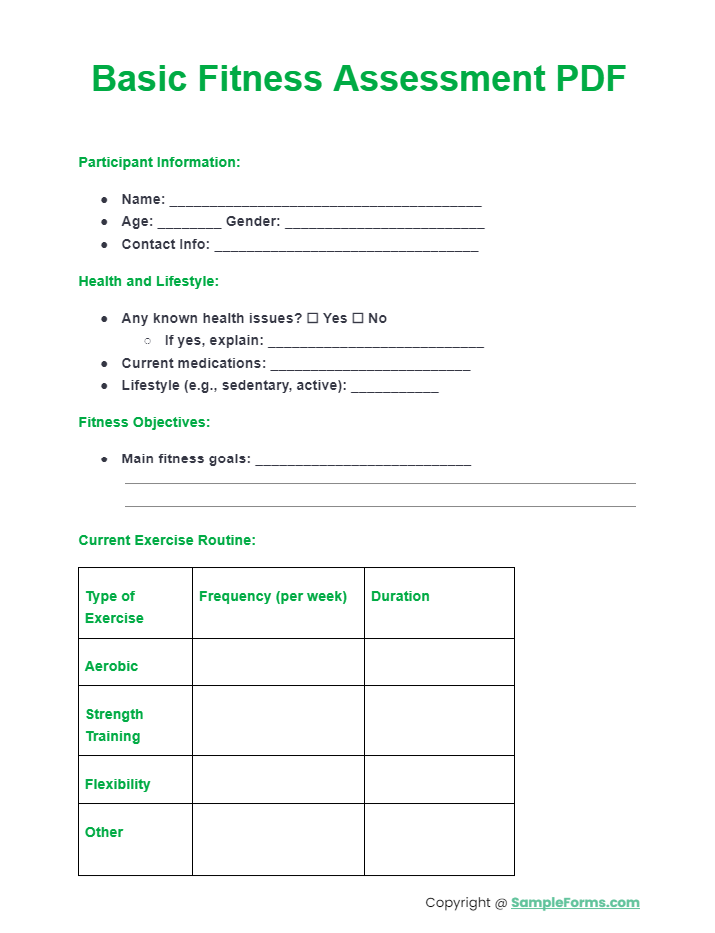
A Basic Fitness Assessment PDF includes fundamental tests for evaluating fitness levels. This easy-to-use form ensures essential fitness data is captured, akin to a Physical Therapy Assessment Form for patient evaluations. In addition, you should review our Fitness Evaluation Form
Personal Trainer Fitness Assessment Form

Personal Trainer Fitness Assessment Form is designed to help trainers evaluate clients’ fitness levels. This specialized form ensures a detailed and personalized assessment, similar to a Nursing Assessment Form for patient care. In addition, you should review our Physical Fitness Form
More Fitness Assessment Form Samples
Fitness Health Assessment Form
Fitness Instructor Assessment Form
Fitness Test Assessment Form in PDF
Fitness Client Assessment Form
General Fitness Assessment Form
Gym Fitness Assessment Form
Medical Fitness Assessment Form
Physical Fitness Assessment Form
Fitness Risk Assessment Form
Fitness Assessment Form Example
Fitness Assessment Test Form
The Advantages of Getting a Fitness Assessment Periodically
- Allows your doctor to check for potential diseases so these can be treated early, eliminated, or controlled.
- Helps to update necessary immunizations.
- Ensures that you are maintaining a healthy lifestyle with proper exercise and a healthy diet.
- Monitors your cholesterol count, blood pressure, and blood sugar levels.
- Identifies tissues or bumps that may be a cause for concern in the future.
When conducting a fitness assessment, be sure to properly document your results or findings by using Physical Assessment Forms. This is to ensure that proper and accurate references are used in the diagnosis of a patient’s health status. In addition, you should review our Business Assessment Form
Steps in Performing a Fitness Assessment
1. Make sure your hands are properly clean and sanitized.
2. Take the patient’s blood pressure.
3. Take the radial pulse by placing your index and middle fingers on the inside of your wrist, below your thumb. Use a watch with a second hand and count your pulse for 60 seconds. Write down your pulse rate, the date, time, and which side was used to take the pulse.
4. Check the patient’s ears.
5. Conduct a hearing test. In addition, you should review our Candidate Assessment Form
6. Perform an eye exam using the Snellen test.
7. Perform an eye exam by testing their eye reaction with a flashlight.
8. Conduct an exam on eye movement by letting the patient follow the direction of your finger using only his eyes.
9. Check the nose and the throat for any signs of inflammation.
10. Perform a check on the neck and on the lymph nodes by determining if there are any glands that are on the neck or on the thyroid that are palpable. In addition, you should review our Infection Control Assessment Form
11. Ask them to raise their eyebrows, frown, close their eyes tightly, show their teeth, smile, and puff out their cheeks to check on their cranial nerves.
12. With the use of a stethoscope, perform a check-up on the lungs. Let the patient breath in deeply and then breathe out while simultaneously doing 3 spot checks on the back of each lung and 1 on the front of each lung.
13. Still with the use of a stethoscope, check on the heart. In addition, you should review our Wellness Assessment Form
14. For the abdominal exam, listen for an aortic bruit by listening for bowel sounds in all 4 quadrants of the abdomen.
15. Palpate the spleen and the liver.
16. Let the patient bend over and touch his toes to assess the function of his spine. In addition, you should review our Income Assessment Form
What is included in a fitness assessment?
A fitness assessment includes various tests and measurements to evaluate an individual’s physical health and fitness levels. Key components include:
- Cardiovascular Endurance: Measures heart and lung efficiency, similar to a Health Assessment Form.
- Muscular Strength: Assesses the maximum force muscles can exert.
- Muscular Endurance: Evaluates the ability to perform repetitive movements.
- Flexibility: Tests the range of motion in joints.
- Body Composition: Analyzes body fat versus lean muscle mass. In addition, you should review our Project Assessment Form
How to create a fitness assessment?
Creating a fitness assessment involves structuring a comprehensive evaluation of physical health. Key steps include:
- Define Objectives: Determine what aspects of fitness you want to measure, similar to a Skills Assessment Form.
- Select Tests: Choose appropriate tests for cardiovascular, strength, endurance, flexibility, and body composition.
- Gather Equipment: Ensure you have the necessary tools for measurements.
- Develop a Form: Create a form to record results, like a Teacher Assessment Form.
- Train Assessors: Educate those conducting the assessments to ensure consistency. In addition, you should review our Education Assessment Form
Who would a fitness assessment benefit and why?
A fitness assessment benefits various individuals by providing insights into their health and fitness levels. Key beneficiaries include:
- Athletes: Helps optimize performance and training.
- Individuals Seeking Weight Loss: Tracks progress and adjusts programs.
- Elderly: Monitors health and mobility.
- Rehabilitation Patients: Guides recovery plans, similar to a Patient Assessment Form.
- General Population: Provides a baseline for fitness improvement. In addition, you should review our Property Assessment Form
How to assess someone’s fitness?
Assessing someone’s fitness involves conducting a series of evaluations to measure different aspects of physical health. Key steps include:
- Interview and Consent: Discuss health history and obtain consent.
- Warm-Up: Ensure the individual warms up before testing.
- Conduct Tests: Perform tests for cardiovascular endurance, strength, flexibility, etc.
- Record Results: Document findings on a structured form, similar to a Child Assessment Form.
- Analyze Data: Compare results against norms and provide feedback. In addition, you should review our Vendor Assessment Form
What are the 5 components of fitness assessment?
The five components of a fitness assessment evaluate different aspects of physical health. Key components include:
- Cardiovascular Endurance: Measures heart and lung efficiency during exercise.
- Muscular Strength: Assesses the ability to exert force.
- Muscular Endurance: Evaluates sustained muscle activity.
- Flexibility: Tests joint range of motion, akin to a Preschool Assessment Form.
- Body Composition: Analyzes fat versus lean muscle mass. In addition, you should review our Supplier Assessment Form
How can I check my fitness level?
You can check your fitness level by performing various physical tests, such as running, push-ups, and flexibility exercises, similar to using a Medical Assessment Form.
Who performs a physical fitness test?
A physical fitness test is typically performed by fitness professionals, personal trainers, or healthcare providers, akin to the role of an assessor for a Self-Assessment Form.
How to test your fitness level?
Test your fitness level by measuring cardiovascular endurance, muscular strength, flexibility, and body composition, using standardized methods similar to those in a Peer Assessment Form.
What is the purpose of physical fitness assessment?
The purpose of physical fitness assessment is to evaluate an individual’s overall health and fitness, set goals, and monitor progress, similar to an Initial Assessment Form.
What is a fit assessment test?
A fit assessment test evaluates physical health through exercises measuring endurance, strength, flexibility, and body composition, akin to filling out Needs Assessment Form.
How to do a body assessment?
Do a body assessment by measuring body composition, such as body fat percentage, and muscle mass, similar to methods used in a Job Assessment Form.
What do you wear to a fitness assessment?
Wear comfortable, breathable clothing and athletic shoes to a fitness assessment, ensuring ease of movement and proper support, similar to preparing for a Security Risk Assessment Form.
What is required for a FIT test?
A FIT test requires collecting a sample to test for blood in the stool, assessing gastrointestinal health, akin to details recorded in a Student Assessment Form.
In conclusion, a Fitness Assessment Form is a vital tool for anyone serious about improving their fitness. Our guide provides detailed Management Risk Assessment Form, sample letters, and practical tips to assist you in creating and using effective fitness assessment forms. By following the strategies and examples provided, you can ensure a thorough evaluation of your fitness level, set realistic goals, and track your progress over time. Utilizing these forms will not only help you achieve your fitness objectives but also maintain motivation and commitment to your fitness journey.
Related Posts
-
Enquiry Form
-
FREE 5+ Recruiter Performance Review Forms in PDF | MS Word
-
Job Safety Observation Form
-
FREE 4+ Hazard Observation Forms in PDF
-
FREE 5+ Coach Observation Forms in PDF | MS Word
-
FREE 4+ Child Care Observation Forms in MS Word | PDF
-
FREE 4+ Child Observation Forms in PDF | MS Word
-
Preschool Observation Form
-
Student Observation Form
-
Peer Observation Form
-
Lesson Observation Form
-
Content Retention Through Assessment Form [ How to, Importance, Tips ]
-
The Importance of Risk Assessment and Safety Statement [ What Is, How to Conduct ]
-
Risk Assessments And Safety Statements Guidelines [ What Is, Process ]
-
Choosing Careers Through Self Assessment [ What Is, Ways ]
